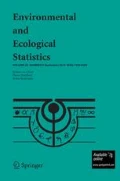Abstract
Calibration of hydrological time-series models is a challenging task since these models give a wide spectrum of output series and calibration procedures require significant amount of time. From a statistical standpoint, this model parameter estimation problem simplifies to finding an inverse solution of a computer model that generates pre-specified time-series output (i.e., realistic output series). In this paper, we propose a modified history matching approach for calibrating the time-series rainfall-runoff models with respect to the real data collected from the state of Georgia, USA. We present the methodology and illustrate the application of the algorithm by carrying a simulation study and the two case studies. Several goodness-of-fit statistics were calculated to assess the model performance. The results showed that the proposed history matching algorithm led to a significant improvement, of 30% and 14% (in terms of root mean squared error) and 26% and 118% (in terms of peak percent threshold statistics), for the two case-studies with Matlab-Simulink and SWAT models, respectively.










Similar content being viewed by others
References
Abbaspour K, Johnson C, Van Genuchten M (2004) Estimating uncertain flow and transport parameters using a sequential uncertainty fitting procedure. Vadose Zone J 3(4):1340–1352
Abbaspour K, Yang J, Maximov I, Siber R, Bogner K, Mieleitner J, Zobrist J, Srinivasan R (2007) Modelling hydrology and water quality in the pre-alpine/alpine thur watershed using swat. J Hydrol 333(2):413–430
Arnold J, Williams J, Srinivasan R, King K, Griggs R (1994) Swat: soil and water assessment tool. US Department of Agriculture, Agricultural Research Service, Grassland, Soil and Water Research Laboratory, Temple
Boyle DP, Gupta HV, Sorooshian S (2000) Toward improved calibration of hydrologic models: combining the strengths of manual and automatic methods. Water Resour Res 36(12):3663–3674
Chu W, Gao X, Sorooshian S (2010) Improving the shuffled complex evolution scheme for optimization of complex nonlinear hydrological systems: application to the calibration of the sacramento soil-moisture accounting model. Water Resour Res 46:W09530. https://doi.org/10.1029/2010WR009224
Dile Y, Berndtsson R, Setegn S (2013) Hydrological response to climate change for gilgel abay river, in the lake tana basin-upper blue nile basin of ethiopia. PLoS ONE 8(10):e79296
Duan Q, Sorooshian S, Gupta V (1992) Effective and efficient global optimization for conceptual rainfall-runoff models. Water Resour Res 28(4):1015–1031
Duncan O, Tollner E, Ssegane H (2013) An instantaneous unit hydrograph for estimating runoff from windrow composting pads. Appl Eng Agric 29(2):209–223
Franchini M, Galeati G (1997) Comparing several genetic algorithm schemes for the calibration of conceptual rainfall-runoff models. Hydrol Sci J 42(3):357–379
Jayakrishnan R, Srinivasan R, Santhi C, Arnold J (2005) Advances in the application of the swat model for water resources management. Hydrol Process 19(3):749–762
Johnson M, Moore L, Ylvisaker D (1990) Minimax and maximin distance designs. J Stat Plan Inference 26(2):131–148
Kalaba L, Wilson B, Haralampides K (2007) A storm water runoff model for open windrow composting sites. Compost Sci Util 15(3):142–150
Krysanova V, Srinivasan R (2015) Assessment of climate and land use change impacts with swat. Reg Environ Change 15(3):431
Loeppky J, Sacks J, Welch W (2009) Choosing the sample size of a computer experiment: a practical guide. Technometrics 51:366–376
Lohani AK, Goel N, Bhatia K (2014) Improving real time flood forecasting using fuzzy inference system. J Hydrol 509:25–41
MacDonald B, Ranjan P, Chipman H (2015) GPfit: an R package for fitting a Gaussian process model to deterministic simulator outputs. J Stat Softw 64(12):1–23
Montanari A, Toth E (2007) Calibration of hydrological models in the spectral domain: an opportunity for scarcely gauged basins? Water Resour Res 43:W05434. https://doi.org/10.1029/2006WR005184
Nash J, Sutcliffe J (1970) River flow forecasting through conceptual models part i—a discussion of principles. J Hydrol 10:282–290
Ranjan P, Bingham D, Michailidis G (2008) Sequential experiment design for contour estimation from complex computer codes. Technometrics 50(4):527–541
Ranjan P, Thomas M, Teismann H, Mukhoti S (2016) Inverse problem for a time-series valued computer simulator via scalarization. Open J Stat 6(03):528–544
Srinivasan M, Gérard-Marchant P, Veith T, Gburek W, Steenhuis T (2005) Watershed scale modeling of critical source areas of runoff generation and phosphorus transport. JAWRA J Am Water Resour Assoc 41(2):361–377
Tigkas D, Christelis V, Tsakiris G (2015) The global optimisation approach for calibrating hydrological models: the case of medbasin-d model. In: Proceedings of the 9th world congress of EWRA, pp 10–13
Vernon I, Goldstein M, Bower R (2010) Galaxy formation: a Bayesian uncertainty analysis. Bayesian Anal 5(4):619–669
Wilson B, Haralampides K, Levesque S (2004) Stormwater runoff from open windrow composting facilities. J Environ Eng Sci 3(6):537–540
Zhang R, Lin CD, Ranjan P (2018) A sequential design approach for calibrating a dynamic population growth model. arXiv:1811.00153
Acknowledgements
The authors would like to thank the Editor, the Associate Editor and two reviewers for their thorough and helpful reviews. Ranjan’s research was partially supported by the Extra Mural Research Fund (EMR/2016/003332/MS) from the Science and Engineering Research Board, Department of Science and Technology, Government of India. Mandal and Tollner’s research was partially supported by 104B State Water Resources Research Institute Program, USA Grant G16AP00047. We would like to thank NASA DEVELOP National Program’s node at the Center for Geospatial Research, UGA for providing resources on SWAT modeling.
Author information
Authors and Affiliations
Corresponding author
Additional information
Handling Editor Pierre Dutilleul.
Rights and permissions
About this article
Cite this article
Bhattacharjee, N.V., Ranjan, P., Mandal, A. et al. A history matching approach for calibrating hydrological models. Environ Ecol Stat 26, 87–105 (2019). https://doi.org/10.1007/s10651-019-00420-9
Received:
Revised:
Published:
Issue Date:
DOI: https://doi.org/10.1007/s10651-019-00420-9




